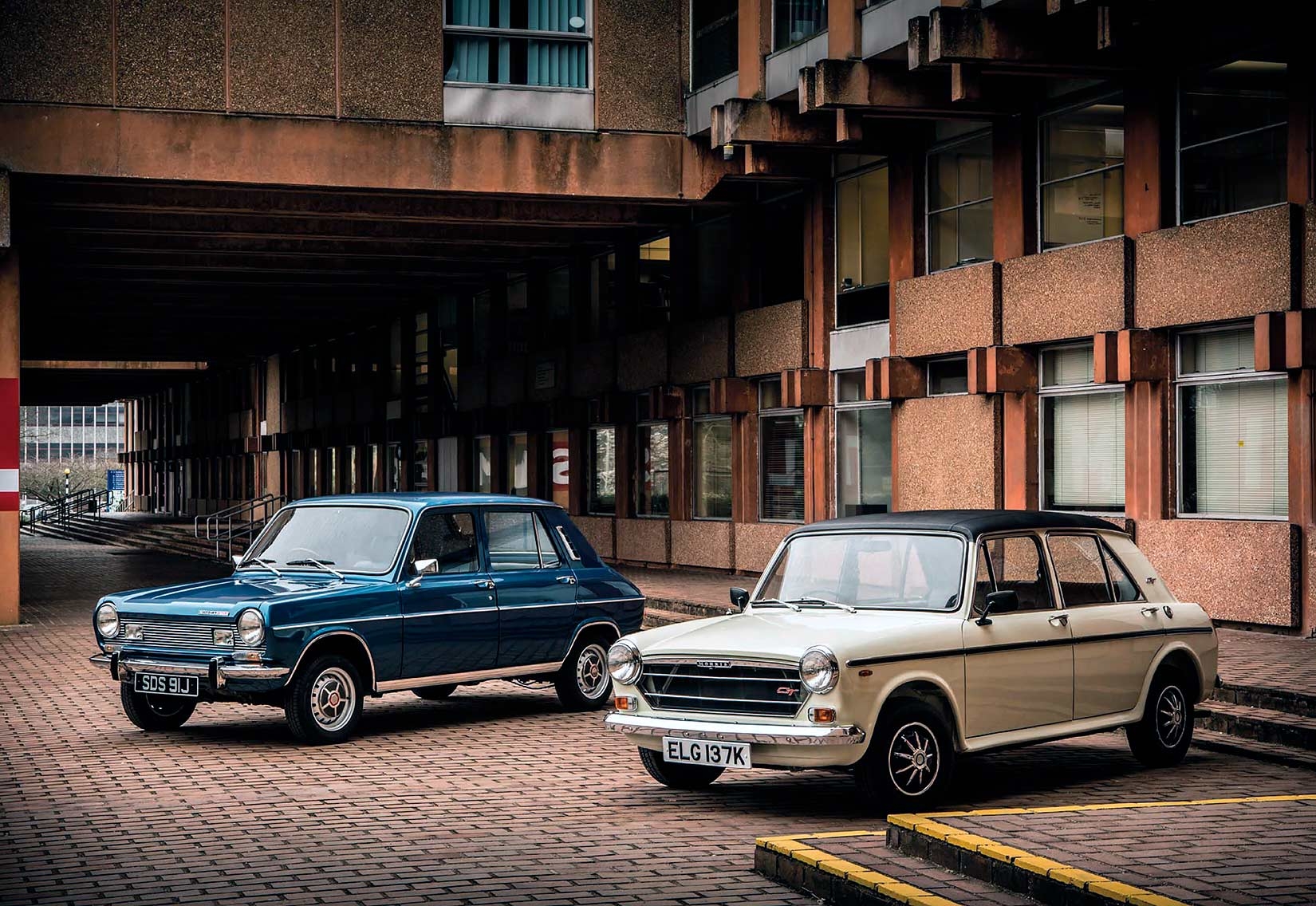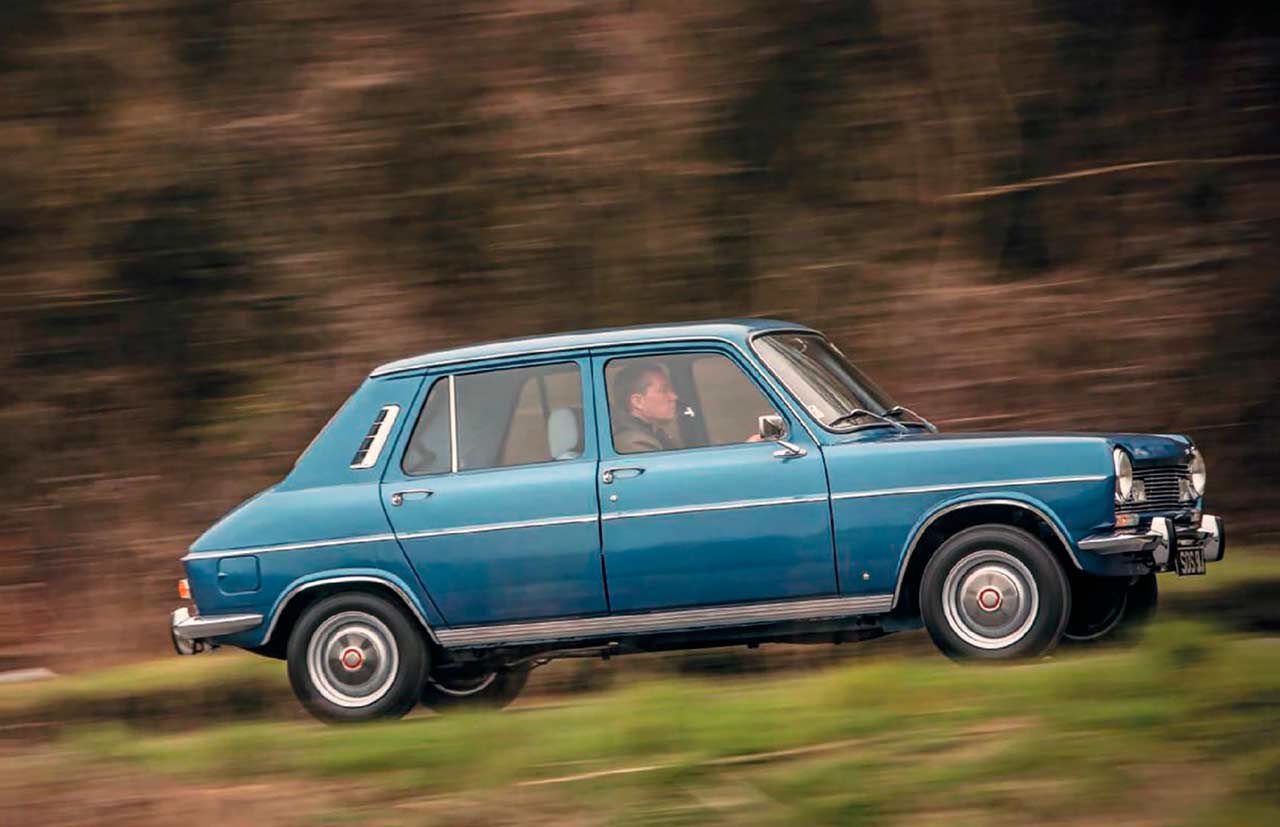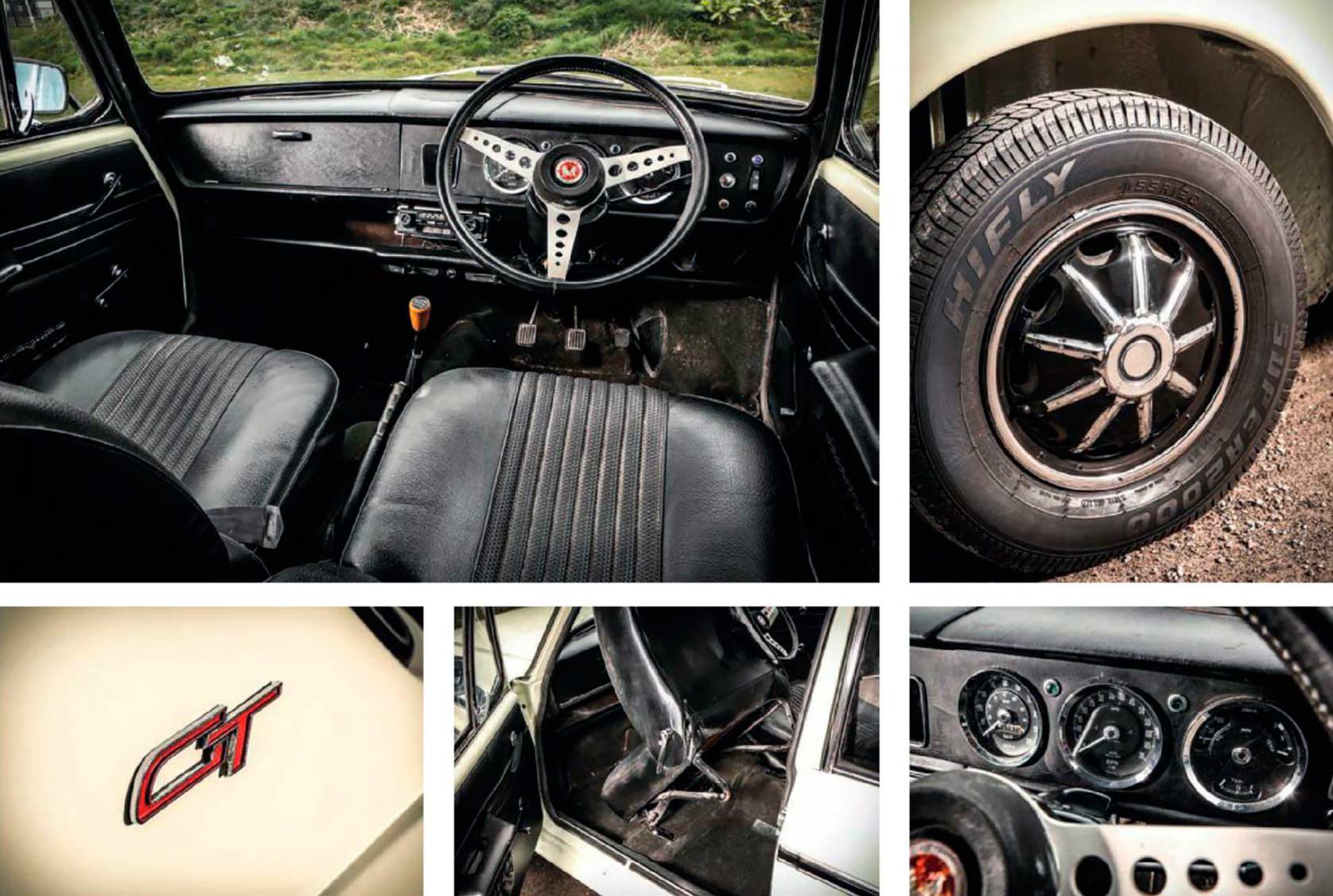
Who says racy Tintops were an ’80s thing? Simca takes on Morris France’s 1204 vs all-Brit 1300GT Fizzbomb showdown Simca battles Morris. 1204 vs 1300GT, zippy small-car rivals from France and the UK. The hot hatch was an evolution of an existing theme, says Andrew Roberts as he compares small sports saloons from Morris and Simca. Photography Tony Baker.
When on location, one of the most intriguing aspects of the day is often the reaction of passers-by to the vehicles being photographed. Sometimes you might overhear sotto voce remarks along the lines of “Jolly crikey! What the blazing Hades is that?” (or words to that effect). This ’71 Morris 1300GT, however, elicited a response of instantaneous recognition. It seemed that so many people at the University of Reading had either owned one as a first or second car, or been taken to school in one. By way of contrast, the Simca 1204 Special attracted plenty of admiring looks but no strong reminiscence of times past.

Test Drive Simca 1204 Special vs. Morris 1300GT. Clipped fins and vertical lights give the 1300GT an older look than the Simca, but it’s undeniably pretty. Below: transverse A-series breathes through twin SUs. Above: Simca motor is fed by a brace of Weber carbs; car features a practical five-door body, and more modern styling than its contemporary from BL.
Yet both are very similar – front-wheel-drive sports saloons that were aimed at ‘professionalclass’ motorists who had outgrown their Mini Cooper. Family responsibilities and expense account lunches meant that they craved rather more space than a Mini 1275GT could offer. The Triumph 1500 was a very comfortable front-drive saloon, but its image was one of middle-aged respectability. Nor was such a clientele overly keen on joining the rear-drive world of the Avenger, Escort or Viva. The 1300GT and the 1204 Special would have both seemed to be the perfect solution and they were even advertised, in the UK at least, on similar lines. ‘Family men; stop yearning for a sports car,’ urged the Simca posters, while the BLMC 1300GT was apparently aimed at the family man suffering from the ‘motoring equivalent of the seven-year itch’. Ah, the halcyon days of sales copy of nearly 50 years ago.

Test Drive Simca 1204 Special
Of our duo of fine test cars, it is the Morris that comes the closest to the stereotype of the 1970s GT saloon, and its debut in late 1969 was rather well-timed. As most readers are already aware, the BMC/BLMC 1100/1300 range was one of a complexity on a par with an episode of The Prisoner and it would take a separate article to explain its intricacies. All that needs to be noted here is that from October 1968 onwards, the MG and Riley 1300s were powered by a 70bhp twin-carburettor 1275cc A-series engine.
The latter version was discontinued the following year, together with all other cars bearing the Blue Diamond, and the Austin/Morris 1300GT represented both its successor and a new form of sporting ADO16. Gone was the older model’s leather trim, walnut veneered dashboard and general associations with Brylcreem, blazers and Leslie Phillips accents. The ‘GT that just had to be’ ushered in a new decade, when hitherto staid chartered accountants donned their first pair of flared slacks and unwisely experimented with Mungo Jerry sideburns.

Clockwise: Simca looks taller than the BL car, but there’s only a couple of inches difference; oblong speedo; neat hubcaps; cabin has a US ambience; minimalist badging is echoed on the fascia.
The BLMC 1300GT was following a new trend for reasonably priced sports saloons that was arguably started by the 1968 HB Series Vauxhall Viva GT with its less-than-subtle exterior decoration combined with plenty of ‘Gran Turismo’ badges. In contrast, the first Escorts to bear the GT insignia – as with the Cortina Mk1 and Mk2 – were fairly low-key in appearance, giving the ADO16 a further chance to shine in the marketplace. There was a vinyl roof, a matt black grille and dashboard, a rear anti-roll bar and slightly lowered suspension, plus sports wheels and – naturally – ‘go faster’ stripes.
The 1300GT was initially marketed as both a Morris and an Austin, with the former ceasing to be available in the UK in 1971 – making ‘our’ car one of the last. It should also be said that possibly only British Leyland could have replaced one model with two in the name of rationalisation.
The two-door MG 1300 also remained in production, just in case the GT’s looks proved too much for conservative drivers.
Back in the early ’70s, some cynics were prone to muttering that GT stood for ‘getting tacky’ but the fact remains that the Morris was a very attractive package. For less than £1000, the proud owner gained a rev counter, a reversing lamp, two-speed wipers and reclining front seats – plus, of course, the dynamic abilities that justly made the ADO16 world famous. The steering is extremely responsive and the Morris’ cornering abilities are the equal of – if not superior to – many a small car of the 1970s and even the early ’80s. Under acceleration the understeer is always predictable, and to derive the best from the GT gearchanges should be made in an unhurried fashion. The engine note may be on the cusp of enthusiastic and exuberant, but the 1300GT will cruise amiably at 65-70mph. The anti-roll bar means that the Morris is less prone to pitching than a 1962-vintage 1100, although the suspension is still arguably best suited to A-roads.

Test Drive Morris 1300GT
Inside, the adjustable backrests do go some way to compensate for that familiar ‘bus driver’ pose, and the dashboard irresistibly reminded me of the days when nearly all would-be Jackie Stewarts would don a pair of mock-leather driving gloves for a trip to the newsagent. The overall cabin space is quite remarkable for a car that is barely more than 12 feet in length, while the compact dimensions make the 1300GT extremely adroit urban transport and serve as an illustration of just how bloated modern ‘small’ cars are. The contrast between the Morris and a recent MINI Countryman is quite startling.
As for those external decorations, they certainly have period charm – the phrase that kept running through my head during the shoot was ‘Terry Scott goes mod’ – and they only add to the enjoyment of what is a very agreeable vehicle. When the GT was launched, the 1100/1300 had already been in production for seven years, but even when the ADO16 was replaced by the Allegro in 1973, the high-performance version was still able to compete with the latest generation of European light saloons.
A further appeal of the Morris is that to nearly anyone of my age (born in the year of the Austin Maxi) it has the power to evoke memories of a time when the A-series transmission whine was an essential aspect of each day’s soundtrack. ADO16s that were variously finished in Flame Red or the especially bright shade of Bronze Yellow could be seen bringing glamour to Above Bar Street, or the car park of the Bitterne branch of Sainsbury’s – all of them making Farina Oxford taxis look positively staid. No doubt my Southampton-based experiences were replicated across the UK and, across the Channel, a 1204 can doubtless provoke similar emotions. After all, it was the flagship of what would become Simca’s best-selling range of all time.

Clockwise: ADO16 was given a ’70s makeover to become the GT, including badges, matt black fascia with sports wheel and alloy-like hubcaps; wellstocked dash; tipping front seats in Morris.
This is a year of automotive anniversaries, and the 50th birthday of the Simca 1100 line-up is one that should not pass unobserved. By ’62 the firm’s management was paying close attention to the front-wheel-drive products of Citroën, not to mention the recently launched Renault 4, and decided to produce its first front-drive model – one that would also bridge the gap between the rear-engined 1000 and the conventional rear-wheel- drive 1300 saloon. It was eventually decided that ‘Project 928’ would have a transverse layout, à la ADO16, with the motor inclined by 30º in order to allow a comparatively low bonnet line. The future Simca 1100 also had to gain the approval of Chrysler – which in 1963 had become became a majority shareholder in the French company – because by any standards it marked a radical step in the marque’s history.
The 1100 made its debut at the 1967 Paris Salon, where it caused no small sensation. Compared to other Gallic front-wheel-drive offerings of the late 1960s, the Simca was faster and more luxurious than the Renault 4, more compact and cheaper than the Renault 16, and had a more youthful image than the Peugeot 204. In June 1970, Simca introduced the first sports version of the 1100 in the form of the 1204 Special, which utilised the engine from the 1200S Coupé. The driver who bought the car that satisfied his or her ‘need for power’ gained a pair of twin-choke Weber carburettors, a three-spoke steering wheel, servo-assisted brakes, extra instruments, head restraints and long-distance driving lights set into the grille.
That first version of the Special was replaced by a 1294cc model for 1972, by which time the 1100 had become the best-selling car in France. By 1973 Simca had produced a million examples and its pioneering five-door design went on to inspire a future generation of hatchbacks. The launch of the Horizon in 1978 marked the arrival of the 1100’s successor in effect. Three years later, production ceased in France, with the final saloons being built in Spain in 1982.
Peugeot had acquired Chrysler’s European operations in 1978, rapidly applying the Talbot badge to Simca products, and by 1980 the famous brand was phased out entirely. The 1204 may have been short-lived – indeed our test car is the sole-surviving UK example known to the Simca Talbot Owners’ Club – but the 1100 was not an uncommon sight on British roads in period.
Today the swallow badge is almost forgotten here, and Britons are more likely to encounter the Simca making a cameo appearance in Fred Zinnemann’s The Day of the Jackal (even if the narrative is set in 1963) than in real life.
That is a great pity, because the 1204 is an exceptionally beguiling vehicle. Its appeal seems to be slightly more refined than that of the Morris, the coachwork looks more formal and the metallic turquoise paint finish helps to give it a less aggressive appearance. The Special may have boasted a ‘simulated wooden steering wheel’ and some quite racy hubcaps, but the first impression is of a car exuding Gallic self-assurance as opposed to suburban boy racer.
The Simca’s cabin is dominated by a fascia that is a masterpiece of non-ergonomics, but there is a commanding driving position and comfortable front seats with head restraints as standard. The 1204 was more expensive in the UK than the 1300GT, but the specification did include a clock and a cigar lighter, while there is the additional bonus of the tailgate. In 1966, the ADO16 was available as a three-door Countryman/ Traveller estate, and in the same year BMC experimented with a five-door hatchback (codenamed YDO9 and eventually built in Australia as the Morris Nomad, although never offered in the UK). In spite of that, the GT never featured such a useful utilitarian touch – it was a further lost opportunity for BMC.
On the road, it soon becomes evident that the 1204’s suspension was designed to cope with not only the Autoroute du Nord but the often very poor roads of rural France and Spain – not to mention Simca’s export markets in Francophone Africa. Anyone who has experienced travel by ADO16 along a badly surfaced country lane will recall how the Hydrolastic set-up would cause the occupants to pitch up and down, but the torsion bars of the Special take nearly all potholes in their stride. The Simca does not quite have the ‘go-kart writ large’ appeal of the Morris, but it presents an excellent compromise between press-on motoring and more sedate journeys. A combination of wellplanned weight distribution, decent brakes and steering that is eminently suited to the Simca being driven with verve. It is also the ideal vehicle with which to counter the arguments of any VW Golf GTI owner about what precisely constitutes the first European hot hatchback.
This was inevitably going to be a difficult choice because both the Morris and the Simca have such unaffected charm. The 1300GT bathes any British motorist of a certain vintage in unabashed nostalgia – Cadbury’s Amazin’ Raisin bars, The Brothers on BBC1 and Chicory Tip singing Son of My Father – and it is also a veritable scaled-up Mini Cooper with four doors. The Simca, meanwhile, gives you the urge to don a pair of shades and a Serge Gainsbourg facial expression (although I might give his Gitanes a miss). In an ideal world, I would have the Morris as a town car for weekdays and the 1204 Special for relaxed weekends with L’Anamour blaring from the eight-track cartridge player.
Thanks to Des Cooke, Mark Parratt, the 1100 Club (www.the1100club.com), the Simca Talbot Owners’ Club (www.simcatalbotclub.org), the University of Reading (www.reading.ac.uk)
TECHNICAL DATA FILE MORRIS 1300GT
Sold/number built 1969-’1971/19,304
Construction steel moncocque
Engine all-iron, OHV 1275cc ‘four’
Max power 70bhp @ 6000rpm
Max torque 74lb ft @ 3250rpm
Transmission four-speed manual, FWD
Suspension independent front wishbones, anti-roll bar rear trailing arms; interconnected Hydrolastic displacers f/r
Steering rack and pinion
Brakes discs/drums, with servo
Length 12ft ½ in (3703mm)
Width 5ft ½ in (1534mm)
Height 4ft 5 ½ in (1359mm)
Weight 1885 lb (855kg)
0-60mph 14.5 secs
Top speed 96 mph
Mpg 28
Price new £909 (1969)
Price now £9000
TECHNICAL DATA FILE SIMCA 1204 SPECIAL
Sold/number built 1967-’1981/2.2m (inc 1100)
Construction steel moncocque
Engine iron-block, alloy-head, OHV 1204cc ‘four’
Max power 75bhp @ 6000rpm
Max torque 76lb ft @ 4500rpm
Transmission four-speed manual, FWD
Suspension independent front wishbones rear trailing arms; torsion bars, telescopic dampers, anti-roll bars f/r
Steering rack and pinion
Brakes discs/drums
Length 13ft (3962mm)
Width 5ft 2in (1575mm)
Height 4ft 8in (1422mm)
Weight 1911lb (867kg)
0-60mph 14.6 secs
Top speed 100mph
Mpg 30
Price new £1038 (1971)
Price now £5000
‘BY ANY STANDARDS, THE SIMCA MARKED A RADICAL STEP IN THE MARQUE’S HISTORY’
‘THE ENGINE NOTE MAY BE ON THE CUSP OF EXUBERANT, BUT THE GT WILL CRUISE AT 70’





